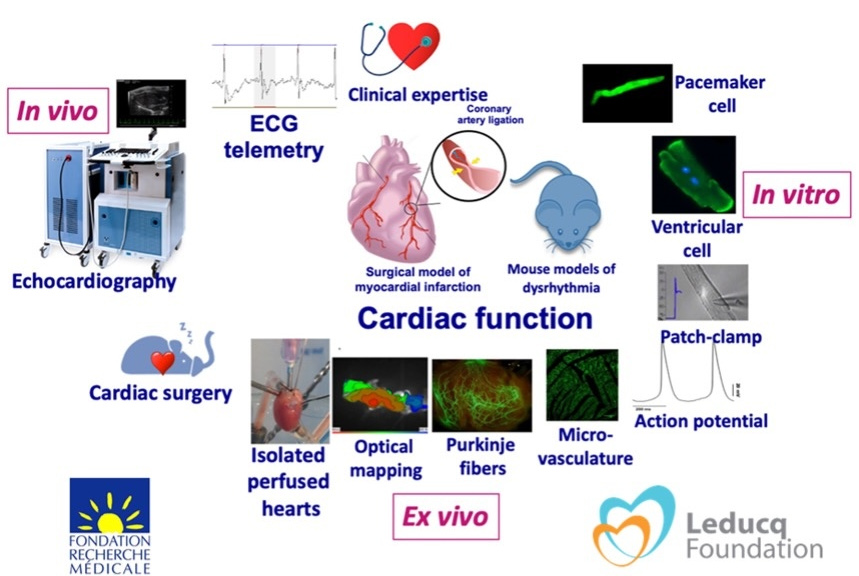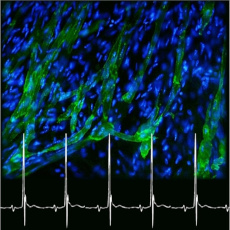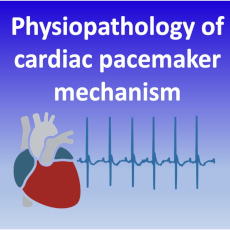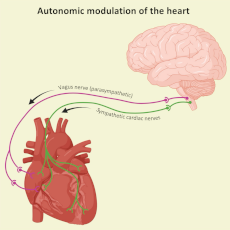Team Stéphanie BARRÈRE-LEMAIRE – Matteo MANGONI
Cardioprotection, pathophysiology of cardiac rhythm and ischemia


Our team is composed of researchers and clinicians. We aim at identifying the pathophysiological mechanisms underlying the generation and regulation of heart automaticity and the mechanisms underlying cell death, which is responsible for myocardial damage associated to infarction, reperfusion and ventricular arrhythmias. We provided both new insights into the role of ion channels in cardiac pacemaker activity and atrioventricular conduction and identified new potential therapeutic targets to protect the heart from rhythmic and ischemic diseases. In addition, we have developed innovative therapeutic strategies undergoing validation in clinical trials. Our team has been labelled by the Fondation pour la Recherche Médicale in 2024 and by the Fondation Leducq in 2020-2026.
Cardiovascular disease, including myocardial infarction and heart rhythm disorders, remain the world’s leading cause of fatalities in 2024. With ageing of population, the World Health Organization forecasts these pathologies to remain the leading cause of mortality until 2030.
Cardiac performance depends on two parameters:
(i) the activity and regulation of the primary heart’s pacemaker centers controlling heart rate, and
(ii) the efficiency of myocardial contraction.
The team’s projects focus on studying the mechanisms involved in the control of cardiac pacemaker activity and in the mechanisms of cell death during myocardial infarction.
The team’s objectives are to develop cardioprotective strategies to normalize heart rate in cardiac disease and inhibit cardiac cell apoptosis, in order to prevent ventricular remodeling and progression to heart failure.
Strategy and techniques
the team uses genetic models of cardiac pathology, such as transgenic mice with brady- or tachyarrhythmia, as well as other rhythm disorders. For infarction, the surgical model of reversible coronary ligation is used to mimic the clinical context of reperfused myocardial infarction as closely as possible.

Our team develops an approach of integrated physiology from organ level to molecular and epigenetic regulatory pathways governing pacemaker activity and cell function. The team has set up all the techniques and models needed to study the pathophysiological mechanisms of cardiac automaticity, heart rhythm and function in pathophysiological models of heart disease.

 IGF Sud 122
IGF Sud 122 04 34 35 92 44
04 34 35 92 44-
2008HDR (Habilitation to direct research) - University of Montpellier
-
1997PhD in Biochemistry, Molecular and Cellular Biology - University of Montpellier
-
1993Master's degree in Health Biology - University of Montpellie
-
2012-Research Director 2nd class CNRS - IGF, Montpellier France.
-
2002-2012Research Associate 1st class CNRS - IGF - Montpellier - France
-
1998-2002Research Associate 2nd class CNRS - Institute of Human Genetics (IGH) - Montpellier - France
-
1997-1998Postdoctoral position, K. Chien's laboratory - UCSD Institute of Molecular Medicine - La Jolla - California - USA
-
1993-1997PhD thesis : Pathophysiology of voltage-activated calcium channels in human cardiac cells - CRBM-CNRS - Montpellier - France
-
2011-Co-director of the "Cardioprotection, Rhythm Pathophysiology and Ischemia" team - Institut de Génomique Fonctionnelle - Montpellier - France
-
2021-2022Winner of the RISE program for Deeptech Founders entrepreneurship training
-
2011Foundation for Medical Research (FRM) Languedoc-Roussillon award
-
2006Foundation for Medical Research (FRM) Languedoc-Roussillon award
-
2000Foundation for Medical Research (FRM) Languedoc-Roussillon award
-
1998Philippe Foundation (NY)
-
1997-1998Foundation for Medical Research (FRM): postdoc fellowship
-
1993-1997Ministry of Higher Education, Research and Labor: thesis grant
- My area of expertise is focused on cardiac pathophysiology and the development of therapeutic strategies to protect myocardial cells.
- More specifically, I study the mechanisms of cell death involved in the pathology of myocardial infarction, in particular the mechanisms of apoptosis. My work also focuses on the study of the cardioprotective mechanisms involved in ischemic conditioning and pharmacological therapeutic strategies.

 IGF Sud 122
IGF Sud 122 04 34 35 92 44
04 34 35 92 44-
2001-2006Visiting Scientist (2 weeks/year), University of Calgary - Alberta - Canada
-
1999-2003Postdoctoral fellow, Institute of Human Genetics (IGH) - Montpellier - France
-
1996-1998Postdoctoral fellow, Center for Research in Macromolecular Biochemistry - Montpellier - France
-
1992-1995Ph.D. in Physiological Sciences, University of Milan - Italy
-
1989-1991Master in Biological Sciences, University of Milan - Italy
-
2017-CNRS Research Director (DR1) at IGF - Montpellier - France
-
2010-2016CNRS Research Director/Senior Scientist (DR2) at IGF - Montpellier - France
-
2003-2010CNRS Research Associate (CR1), Institute of Functional Genomics (IGF) - Montpellier - France
-
2019-2024Member of the FRM panel "prix Béziat-Rouanet"; panel chairman since 2022
-
2021-2026Head Department of Physiology and Cancer, IGF
-
2012-2024Member of the steering committee of LabEx “Ion channels and Therapeutics” (ICST)
-
2017-2019Member of the scientific board of the meeting of the French Ion Channels Association
-
2016-2020Nucleus Member of the European Working Group of Cardiac Cellular Electrophysiology (EWGCCE)
-
2015-2020Responsible of the "Biology of Ion Channels" research axis at IGF
-
2012-2014Head of the Department of Physiology, IGF
-
2011-Team leader at the IGF, CNRS UMR5203, Inserm U1191, Univ. Montpellier
-
2000Claude-Adolphe Nativelle Prize awarded by the French Society of Cardiology
- My research team focusses on the mechanisms underlying the generation and control of the heartbeat. We also develop a specific research plan to identify new therapeutic targets for improving the heart rate in diseases of heart automaticity. We focus on the functional role of ion channels, receptors and intracellular calcium dynamics in sinus node physiology as well as conduction of the cardiac impulse.
- We have described the roles of voltage-gated Ca2+ , “funny” f-(HCN4), G protein gated (GIRK) and transient receptor potential (TRPM7) channels in cardiac pacemaker activity.
- We also recently proposed the concept of “compensatory” GIRK channel targeting for the development of a new pharmacologic therapy to improve heart rate in sinus node dysfunction.
- We have developed cutting-edge genetic and cellular models of cardiac pacemaker activity and routinely employ state of the art technologies and facilities available in our Institute, including electrophysiology, cell biology, genomics, calcium imaging and numerical modelling of automaticity.
- We obtained several grants on sinus node physiology or dysfunction from French agencies as PI or in partnership with outstanding colleagues. Network based work has been paramount for our research activity. We have been partners of the EU RTN Network project CavNet, to explore the role of voltage-gated L-type Cav1.3 calcium channels in the cardiovascular, neuroendocrine and nervous systems. My team is currently partner of the French Laboratory of Excellence (LabEx) Network Ion Channels Science and Therapeutics (ICST), a collaborative network devoted to the study of ion channels as therapeutic targets. In addition, I am European coordinator of the Leducq Foundation Transatlantic Network of Excellence FANTASY.

 IGF Sud 126
IGF Sud 126 04 34 35 92 46
04 34 35 92 46

 IGF Sud 126
IGF Sud 126 04 34 35 92 46
04 34 35 92 46-
2022Habilitation to Supervise Research (HDR) - University of Montpellier - France
-
2007PhD in Physics - University of Bologna - Italy
-
1998Degree in Physics - University of Bologna - Italy
-
2016-Research Associate (CRCN) INSERM - IGF - Montpellier - France
-
2007-2016Postdoctoral fellow - IGF - Montpellier - France
-
2000-2007Postdoctoral fellow - Department of Physics - University of Bologna - Italy
-
2020-Scientific Council of the ‘Association Canaux ioniques’
-
2015Les Grandes Avancées en Biologie-Santé du Pôle Rabelais’ award - Montpellier - France
- My research activities focus on the mechanisms underlying cardiac automaticity. In particular, I work on the ionic and cellular mechanisms controlling pacemaking in various mouse models and also, recently in patient-derived pacemaker cardiomyocytes.
- My research interests include:
- Electrophysiological measurements in vitro and in vivo (extracellular field potential recording technique, patch clamp technique, ECG recordings, etc.)
- Study of intracellular Ca2+ handling
- Ion channels biophysics
- In silico modeling

 IGF Sud 122
IGF Sud 122 04 34 35 92 44
04 34 35 92 44

 IGF Sud 126
IGF Sud 126 04 34 35 92 46
04 34 35 92 46-
2018-2020Master in business and administration (MBA) - "Institut d'Administration des Entreprises" (IAE) - Montpellier - France
-
2007-2011PhD in Animal Physiology - University of Montpellier - In Frame of the Marie Curie Excellence Network "CavNet" (6th FP MRTN-CT-2006), Host Institute: IGF - Montpellier - France
-
2003-2004Erasmus/Socrates Exchange Student - University of Salamanca - Espagna
-
1998-2005Biological Sciences Degree - University of Palermo - Italy
-
2019-CNRS Permanent Research associate - IGF - Montpellier - France
-
2016-2019Senior Postdoctoral Scientist - IGF - Montpellier - France
-
2012-2015Postdoctoral Scientist - Heart Institute (Dir. Dr. E Marban) - Cedars-Sinai Medical Center - Los Angeles - USA
-
2011-2011Assistant Engineer - IGF - Montpellier - France
-
2019Seal of Excellence of the Marie Skłodowska-Curie Actions call H2020-MSCA-IF- 2019 - Total score: 92.00%
-
2017Prize "Grandes Avancées du Pole Rabelais" Université de Montpellier
-
2016Poster Award - European Society of Cardiology - WGCCE - Glasgow - UK
-
2015Travel Award - International Society of Heart Research - Seattle - USA
-
2015Merit Award in Poster Competition - 7th Gordon Research Conference on Cardiac Arrhythmia Mechanism - Lucca - Italy
-
2014Travel Award - European Society of Cardiology - Barcelona - Spain
-
2013Finalist of Malaniak Award for Excellence in Postdoctoral Research - Cedars-Sinai Medical Center - Los Angeles - USA
-
2011First Price - Basic Electrophysiology Poster - Denis Escande Symposium - Nantes - France
- My academic career was mainly focused on the study of the fundamental mechanism of cardiac pacemaker activity. In particular, I used pharmacological strategies to recover pacemaker activity in transgenic mice and other animal models mimicking human heart diseases.
- I’m now strongly interested in the use of heart rate variability to infer the modulatory activity of the autonomic nervous system on the heart in the context of aging and to study the behavior of wild animals such as cetaceans, sea birds and sea turtles.

 IGF Sud 122
IGF Sud 122 04 34 35 92 44
04 34 35 92 44-
2013Habilitation to Supervise Research (HDR) - University of Montpellier 2
-
1997PhD in Neuroscience - Aix-Marseille III University
-
1994DEA in Neuroscience - Aix-Marseille III University
-
2024-Professor - University of Montpellier
-
2002-2023Senior Lecturer - University of Montpellier
-
1999-2002Senior Lecturer - Nancy 1 University
-
1985-1990Postdoctorate - University of California San Diego (UCSD) - USA
-
1994-1997Thesis - Faculté des Sciences de St Jérôme - Marseille
-
1994-1997Lecturer in Higher Education - CIES PACA
-
2021-Deputy Director BIO-MV Teaching Department - Faculty of Science
-
2015-2018Elected member of the Board BIO-MV Teaching Department - Faculty of Science
-
2015-2018Elected member of the Academic Council (CAc) - University of Montpellier
-
2015-2018Member of the CAc Research Commission - Université de Montpellier
-
2013-2017Member of expert panels - Université de Montpellier (section CNU 66).
-
2013-2016Elected member of the Comité Thématique d'Etablissement Biologie-Santé
-
2009-2013Member of selection committees/expert groups CNU 66-69 UM2
-
2004-2008Member of the specialist commission (CNU 66-69) - UM2
-
2001-2002Elected member of the Pedagogical Council, Faculty of Medicine - Nancy 1
-
2000-2002Director of Studies, IUP Health Engineering, Faculty of Medicine - Nancy 1
- Immunohistochemistry
- In situ hybridization
- Molecular biology: RT-PCR, qPCR, Extraction, biochemical tests
- Electrophysiology

 IGF Sud 121
IGF Sud 121 04 34 35 92 45
04 34 35 92 45

 IGF Sud 121
IGF Sud 121 04 34 35 92 45
04 34 35 92 45

 IGF Sud 126
IGF Sud 126 04 34 35 92 46
04 34 35 92 46- BTEC Higher National Diploma in Software development et Electronics
- Electronician technician, Computer technicien then Computer Engineer
- Data Analysis, Signal processing, Computational Electrophysiology in Cardiology.
- Matlab et R programming.

 IGF Sud 126
IGF Sud 126 04 34 35 92 46
04 34 35 92 46-
2017-2021PhD – Molecular and Cell Biology - University of Milano – Milano
-
2014-2017Master’s Degree – Medical Biotechnologies - University of Modena and Reggio Emilia - Modena
-
2010-2014Bachelor Degree – Biotechnologies - University Vita-Salute San Raffaele - Milano
-
2024-Postdoctoral Fellow – Institute de Genomique Fonctionnelle - Montpellier – France
-
2021-2024Postdoctoral Fellow – University of Milano - Milano – Italy
-
2017-2021PhD student – University of Milano – Milano - Italy
- Distinctions
-
2024-Postdoctoral fellowship by Marion Elizabeth Brancher Fond
-
2021-2024PNRR postdoctoral fellowship
- I am a Molecular and Cell biologist with a strong background in Biotechnologies. Hence, I’m fascinated by the idea to design innovative biotechnology-based therapies for human diseases, testing their feasibility in human cells. My research interests include:
- cell cultures;
- molecular biology techniques (cloning plasmid, Western Blot, rt-qPCR);
- transcriptomic analysis (RNA-seq)
- epigenetic

 IGF Sud 122
IGF Sud 122 04 34 35 92 44
04 34 35 92 44

 IGF Sud 126
IGF Sud 126 04 34 35 92 44
04 34 35 92 44

 IGF Sud 126
IGF Sud 126 04 34 35 92 46
04 34 35 92 46

 IGF Sud 126
IGF Sud 126 04 34 35 92 46
04 34 35 92 46
- Master's degree in Biology-Health Experimental and Regenerative Medicine
- Bachelor's degree in Life Sciences Animal Physiology and Neuroscience

 IGF Sud 126
IGF Sud 126 04 34 35 92 44
04 34 35 92 44

 IGF Sud 122
IGF Sud 122 04 34 35 92 44
04 34 35 92 44

 IGF Sud 126
IGF Sud 126 04 34 35 92 46
04 34 35 92 46

 IGF Sud 126
IGF Sud 126 04 34 35 92 44
04 34 35 92 44

 IGF Sud 126
IGF Sud 126 04 34 35 92 46
04 34 35 92 46
 IGF Sud 126
IGF Sud 126 04 34 35 92 46
04 34 35 92 46

 IGF Sud 126
IGF Sud 126 04 34 35 92 46
04 34 35 92 46
- Tikhomirov R, Oakley RH, Anderson C, Xiang Y, Al-Othman S, Smith M, Yaar S, Torre E, Li J, Wilson LR, Goulding DR, Donaldson I, Harno E, Soattin L, Shiels HA, Morris GM, Zhang H, Boyett MR, Cidlowski JA, Mesirca P, Mangoni ME, D’Souza A. Cardiac GR Mediates the Diurnal Rhythm in Ventricular Arrhythmia Susceptibility Circ Res 2024, 134:1306-1326, doi: 10.1161/CIRCRESAHA.123.323464
- Mesirca P, Chemin J, Barrère C, Torre E, Gallot L, Monteil A, Bidaud I, Diochot S, Lazdunski M, Soong TW, Barrère-Lemaire S, Mangoni ME, Nargeot J.Selective blockade of Cav2 (α1C) versus Cav1.3 (α1D) L-type calcium channels by the black mamba toxin calciseptine Nat Commun 2024, 15:54. doi: 10.1038/s41467-023-43502-w.
- Louradour J, Bortolotti O, Torre E, Bidaud I, Lamb N, Fernandez A, Le Guennec JY, Mangoni ME, Mesirca P. L-Type Cav3 Calcium Channels Are Required for Beta-Adrenergic Triggered Automaticity in Dormant Mouse Sinoatrial Pacemaker Cells Cells 2022, 25,11,1114. doi: 10.3390/cells11071114.
- Mesirca P, Fedorov VV, Hund TJ, Torrente AG, Bidaud I, Mohler PJ, Mangoni ME. Pharmacologic Approach to Sinoatrial Node Dysfunction Annu Rev Pharmacol Toxicol 2021, 61:757-778. doi: 10.1146/annurev-pharmtox-031120-115815
- Barrère-Lemaire S, Vincent A, Jorgensen C, Piot C, Nargeot J, Djouad F. Mesenchymal stromal cells for improvement of cardiac function following acute myocardial infarction: a matter of timing. Physiol Rev. 2024 Apr 1;104(2):659-725. doi:10.1152/physrev.00009.2023. PMID: 37589393.
- Delgado-Betancourt V., Kroekkiat C., Mesirca P., Barrère C., Covinhes A., Gallot L., Vincent A., Bidaud I., Kumphune S., Nargeot J., Piot C, Wickman, K, Mangoni M.E#, Barrère-Lemaire S#. Heart rate reduction after genetic ablation of L-type Cav1.3 channels induces cardioprotection against ischemia-reperfusion injury. Frontiers in cardiovascular medicine. 2023 Aug 1;10:1134503. doi: 10.3389/fcvm.2023.1134503. PMID: 37593151
- Sarre C, Contreras-Lopez R, Nernpermpisooth N, Barrere C, Bahraoui S, Terraza C, Tejedor G, Vincent A, Luz-Crawford P, Kongpol K, Kumphune S, Piot C, Nargeot J, Jorgensen C, Djouad F#, Barrere-Lemaire S#. Peroxisome Proliferator-Activated Receptor Beta/Delta agonist enhances the anti-apoptotic and therapeutic properties of mesenchymal stem cells in myocardial ischemia-reperfusion injury. Stem cell research & therapy 2022; 13:167. doi:10.1186/s13287-022-02840-0. PMID: 35461240.
- Mesirca P, Nakao S, Nissen SD, Forte G, Anderson C, Trussell T, Li J, Cox C, Zi M, Logantha S, Yaar S, Cartensen H, Bidaud I, Stuart L, Soattin L, Morris GM, da Costa Martins PA, Cartwright EJ, Oceandy D, Mangoni ME, Jespersen T, Buhl R, Dobrzynski H, Boyett MR, D’Souza A. Intrinsic Electrical Remodeling Underlies Atrioventricular Block in Athletes Circ Res. 2021;129(1):e1-e20. doi:10.1161/CIRCRESAHA.119.316386. Epub 2021 Apr 14.
- Baudot M, Torre E, Bidaud I, Louradour J, Torrente AG, Fossier L, Talssi L, Nargeot J, Barrère-Lemaire S, Mesirca P, Mangoni ME. Concomitant genetic ablation of L-type Cav3 (α1D) and T-type Cav3.1 (α1G) Ca2+ channels disrupts heart automaticity Sci Rep 2020 10, 18906. doi: 10.1038/s41598-020-76049-7.
- Covinhes A, Gallot L, Barrère C, Vincent A, Sportouch C, Piot C, Lebleu B, Nargeot J, Boisguérin P, Barrère-Lemaire S. Anti-apoptotic peptide for long term cardioprotection in a mouse model of myocardial ischemia-reperfusion injury. Sci Rep. 2020 Oct 22;10(1):18116. doi:10.1038/s41598-020-75154-x

Ion channels in the genesis and regulation of heart rate and rhythm
Principal investigator
Matteo E. MANGONI
![]()
Study of the mechanisms of cell death involved in myocardial ischemia-reperfusion injury and development of cardioprotective strategies
Principal investigator
Stéphanie BARRERE-LEMAIRE

Understanding the physiopathology of cardiac pacemaker mechanism to manage sinus node dysfunction and heart block
Principal investigator
Pietro MESIRCA

Modulation of cardiac activity by the autonomic nervous system: effect of ageing and application to the ethology of marine species
Principal investigator
Angelo TORRENTE




